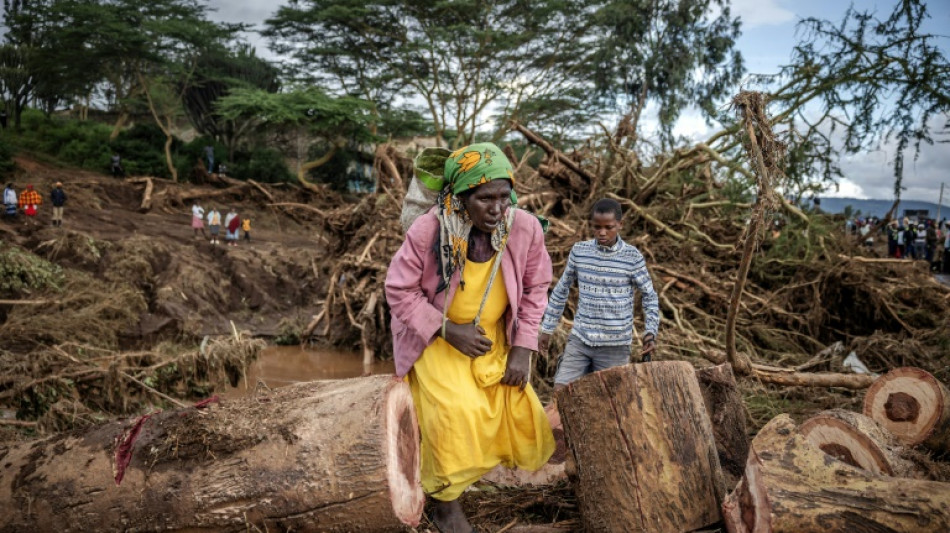
Kenya, Tanzania brace for cyclone as heavy rains persist

Kenya and Tanzania were bracing Thursday for a cyclone on the heels of torrential rains that have devastated East Africa, killing more than 350 people and forcing tens of thousands from their homes.
In addition to claiming 188 lives in Kenya since March, the floods have displaced 165,000 people, with 90 reported missing, the interior ministry said, as the government warned citizens to remain on alert.
"Crucially, the coastal region is likely to experience Cyclone Hidaya, which will result in heavy rainfall, large waves and strong winds that could affect marine activities in the Indian Ocean," the office of Kenyan President William Ruto said.
Neighbouring Tanzania, where at least 155 people have been killed in flooding and landslides, is also expected to feel the force of Hidaya.
"The presence of Hidaya Cyclone... is expected to dominate and affect the weather patterns in the country including heavy rain and strong winds in some Regions near Indian Ocean," Tanzania Red Cross Society said on X, the former Twitter.
Kenya's capital Nairobi is among the areas expected to suffer heavy rains over the next two days, the Kenya Meteorological Department said on X.
The heavier than usual rains have also cost at least 29 lives in Burundi, with 175 people injured, and tens of thousands displaced since September last year, the United Nations said.
- Stranded tourists -
The devastation has also affected Kenya's tourism sector -- a key economic driver -- with some 100 tourists marooned in the famed Maasai Mara wildlife reserve on Wednesday after a river overflowed, flooding lodges and safari camps.
Rescuers later managed to evacuate 90 people by ground and air, the interior ministry said.
The area is currently inaccessible with bridges washed away, Narok West sub-county administrator Stephen Nakola told AFP, adding that about 50 camps in the reserve have been affected, putting more than 500 locals temporarily out of work.
There are no fatalities but communities living around the area have been forced to move away.
"Accessing the Mara is now a nightmare and the people stuck there are really worried, they don't have an exit route," Nakola said, adding that waterborne diseases were likely to emerge.
"I am worried that the situation could get worse because the rains are still on."
In the deadliest single incident in Kenya, dozens of villagers were killed when a dam burst on Monday near Mai Mahiu in the Rift Valley, about 60 kilometres (40 miles) north of the capital, Nairobi.
The interior ministry said 52 bodies had been recovered and 51 people were still missing after the dam disaster.
- 'Travel warnings' -
Kenyan President William Ruto on Tuesday announced he was deploying the military to evacuate everyone living in flood-prone areas.
Opposition politicians and lobby groups have accused Ruto's government of being unprepared and slow to respond to the crisis despite weather warnings, demanding that it declare the floods a national disaster.
"Kenya's government has a human rights obligation to prevent foreseeable harm from climate change and extreme weather events and to protect people when a disaster strikes," Human Rights Watch said Thursday.
The United States and Britain have issued travel warnings for Kenya, urging their nationals to be cautious amid the extreme weather.
The devastation has sparked an outpouring of condolences and pledges of solidarity from all over the world, including from Pope Francis and UN Secretary General Antonio Guterres.
The United Arab Emirates has dispatched two aircraft to Kenya carrying 80 tonnes of "essential relief supplies", Kenyan government spokesman Isaac Mwaura said in a statement posted on X on Thursday.
The rains have been amplified by the El Nino weather pattern -- a naturally occurring climate phenomenon typically associated with increased heat worldwide, leading to drought in some parts of the world and heavy downpours elsewhere.
(P.Vasilyevsky--DTZ)
